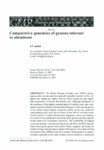Please use this identifier to cite or link to this item:
http://www.alice.cnptia.embrapa.br/alice/handle/doc/855075| Title: | Comparative genomics of grasses tolerant to aluminum. |
| Authors: | JARDIM, S. N.  |
| Affiliation: | SILVIA NETO JARDIM BELICUAS, CNPMS. |
| Date Issued: | 2007 |
| Citation: | Genetics and Molecular Research, Ribeirão Preto, v. 6, n. 4, p. 1178-1189, 2007. |
| Description: | The family Poaceae includes over 10,000 species, among which are the most economically important cereals: maize, sorghum, rice, wheat, rye, barley, and oat. These cereals are very important components of human and animal food. Although divergence of the members of this family occurred about 40 million years ago, comparative genome analyses demonstrated that gene orders among species of this family remain largely conserved, which can be very useful for understanding their roles and evolution. Even with an intricate evolutionary history in which chromosome fragments, losses and duplications have to be considered at the ploidy level, grasses present a genetic model system for comparative genomics. The availability of mapped molecular markers, rice genome sequences and BAC and EST libraries from several grass species, such as rice, wheat, sorghum, and maize, facilitates biology and phylogeny studies of this group. The value of using information from different species in modern plant genetics is unquestionable, especially in the study of traits such as tolerance to aluminum in soils, which affects plant growth and development. Comparative genomic approaches to aluminum tolerance can identify genomic regions and genes responsible for aluminum tolerance in grasses. |
| Thesagro: | Genética Vegetal |
| Keywords: | Tolerância ao alumínio |
| Type of Material: | Artigo de periódico |
| Access: | openAccess |
| Appears in Collections: | Artigo em periódico indexado (CNPMS)  |
Files in This Item:
| File | Description | Size | Format | |
|---|---|---|---|---|
| Comparativegenomics.pdf | 10.53 MB | Adobe PDF |  View/Open |









